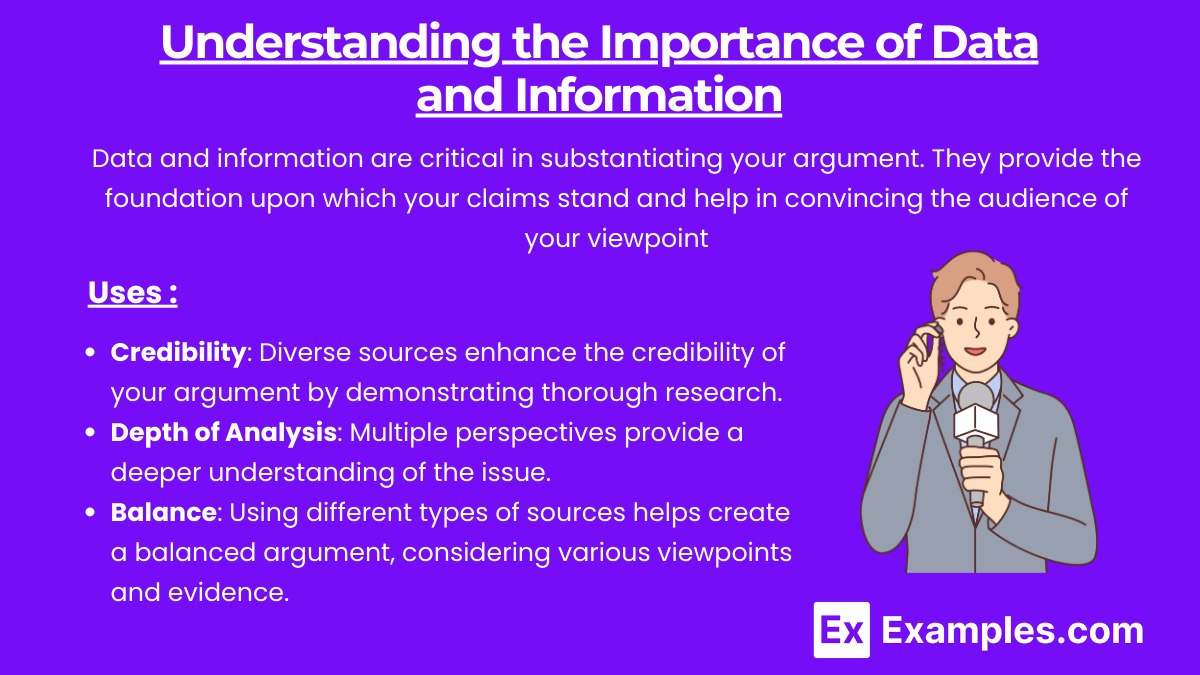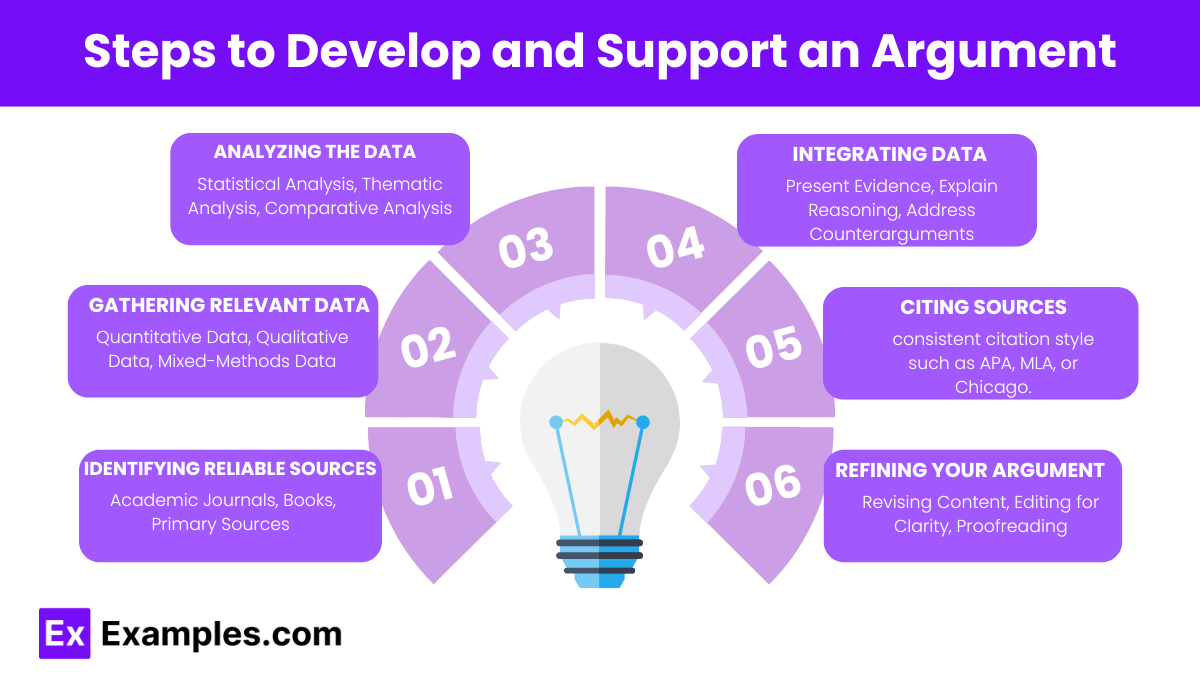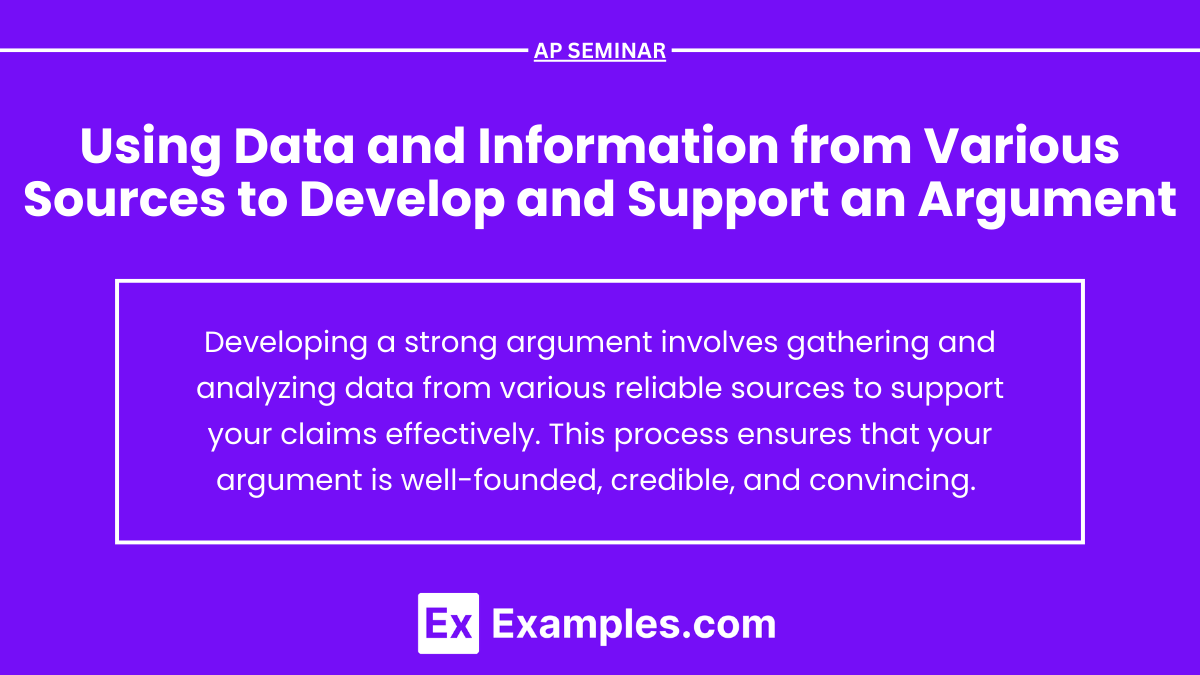Developing a strong argument involves gathering and analyzing data from various reliable sources to support your claims effectively. This process ensures that your argument is well-founded, credible, and convincing. By identifying credible sources, collecting relevant quantitative and qualitative data, and integrating this information logically, you can create a coherent and persuasive argument. Proper citation and addressing counterarguments further strengthen your position, making your argument robust and comprehensive. This approach is essential for success in the AP Seminar Exam.
Learning Objectives
In the AP Seminar exam, you should learn to identify and evaluate credible sources, gather and analyze relevant quanlitative and quatitative data, and integrate this information to construct a well-supported argument. Focus on developing skills in logical reasoning, effective citation, and addressing counterarguments. Master the ability to present data clearly, connect evidence to your claims, and maintain the credibility of your argument. These skills will enable you to create compelling, well-founded arguments essential for success in the exam.
Understanding the Importance of Data and Information

Data and information are critical in substantiating your argument. They provide the foundation upon which your claims stand and help in convincing the audience of your viewpoint.
Why Use Various Sources?
- Credibility: Diverse sources enhance the credibility of your argument by demonstrating thorough research.
- Depth of Analysis: Multiple perspectives provide a deeper understanding of the issue.
- Balance: Using different types of sources helps create a balanced argument, considering various viewpoints and evidence.
Steps to Develop and Support an Argument

1. Identifying Reliable Sources
To develop a strong argument, begin by identifying reliable and credible sources. Consider the following types of sources:
- Academic Journals: Peer-reviewed articles provide high-quality and reliable information.
- Books: Scholarly books, especially those published by reputable publishers.
- Government Publications: Official reports and statistics.
- Reputable News Outlets: Established newspapers and news websites.
- Primary Sources: Original documents, eyewitness accounts, or data.
- Tip: Always evaluate the credibility of a source by considering the author’s qualifications, publication date, and the source’s reputation.
2. Gathering Relevant Data
Collect data that directly supports your argument. Focus on:
- Quantitative Data: Numerical data such as statistics, charts, and graphs.
- Qualitative Data: Descriptive data including interviews, case studies, and ethnographic research.
- Mixed-Methods Data: Combination of both quantitative and qualitative data.
- Example: If your argument is about the effectiveness of renewable energy, gather data on energy production, cost efficiency, and environmental impact.
3. Analyzing the Data
Once you have gathered the data, analyze it to draw meaningful conclusions. Use:
- Statistical Analysis: To interpret numerical data.
- Thematic Analysis: To identify patterns and themes in qualitative data.
- Comparative Analysis: To compare and contrast different sets of data.
- Tip: Ensure your analysis is unbiased and considers all relevant data points.
4. Integrating Data into Your Argument
Integrate your data and findings into your argument logically and coherently. Follow these steps:
- Present Evidence: Clearly present your data and explain its relevance.
- Explain Reasoning: Connect the data to your main claim, showing how it supports your argument.
- Address Counterarguments: Use data to refute opposing viewpoints.
- Example: “According to the U.S. Department of Energy, wind energy production increased by 15% in the last decade, providing a cost-effective and environmentally friendly alternative to fossil fuels.”
5. Citing Sources
Properly cite all sources to avoid plagiarism and to lend credibility to your argument. Use a consistent citation style such as APA, MLA, or Chicago.
Tip: Include in-text citations and a bibliography or works cited page.
6. Reviewing and Refining Your Argument
Before finalizing your argument, review and refine it to ensure clarity and strength. Consider:
- Revising Content: Check for logical flow and coherence.
- Editing for Clarity: Ensure your argument is clear and concise.
- Proofreading: Correct any grammatical or typographical errors.
Common Pitfalls to Avoid
- Overreliance on One Source: Diversify your sources to avoid bias.
- Ignoring Counterarguments: Address opposing views to strengthen your argument.
- Misinterpreting Data: Ensure accurate interpretation of data to avoid misleading conclusions.
- Poor Citation: Always cite your sources properly to maintain credibility.


